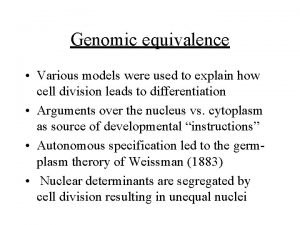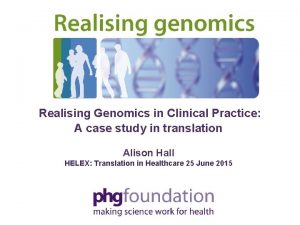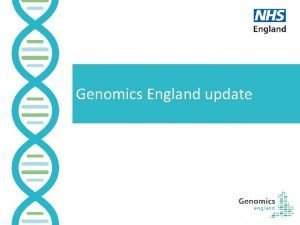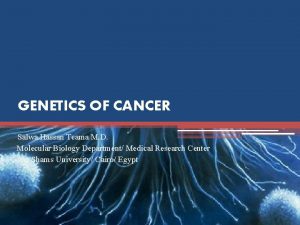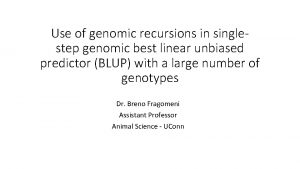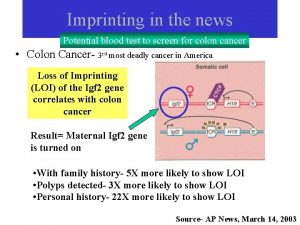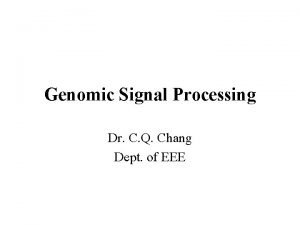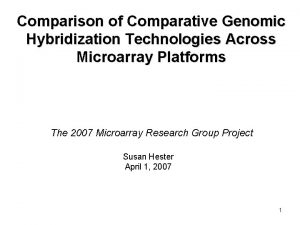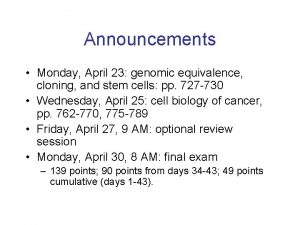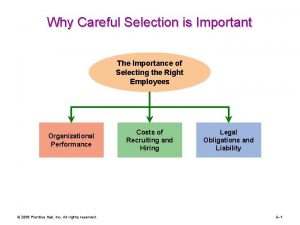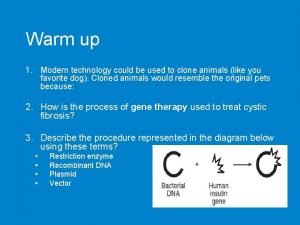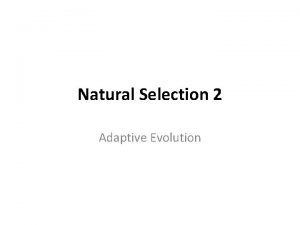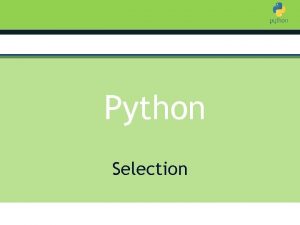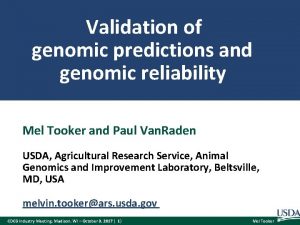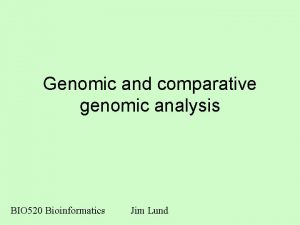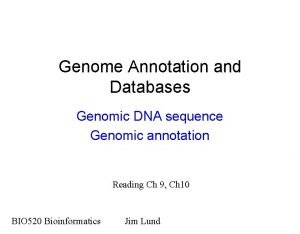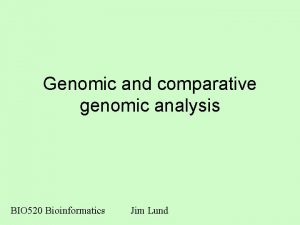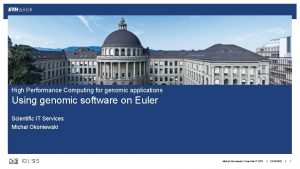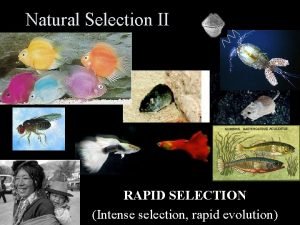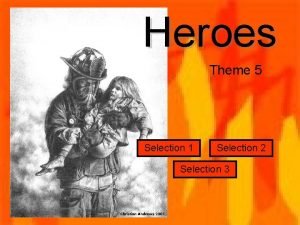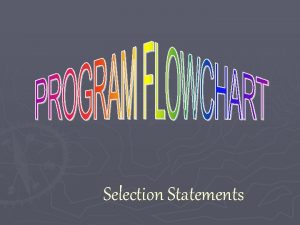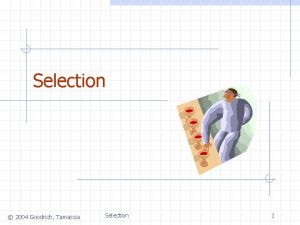imagefriend com Introduction to Genomic Selection WHY USE





























- Slides: 29

imagefriend. com Introduction to Genomic Selection

WHY USE SELECTION? Estimated cost to raise a heifer is $2000 -$3000 Second greatest expense for dairy after feed costs To improve performance • Nutrition • Hygiene • Health program Selection • Genetics

ACHIEVEMENT OF GENETIC CHANGE IN RESPONSE TO SELECTION

SELECTION PEDIGREE-BASED PTA Predicted Transmitting Ability (PTA) • Estimates the future offspring’s performance based on records obtained from: - Own performance - Relative’s performance (pedigree) - Past offspring’s performance • Accuracy of prediction is typically poor until a large number of progeny have performance records

SELECTION PREDICTION EQUATIONS The PTA measures the expected difference between the animal’s offspring and the mean of all offspring for that trait. mean of the herd’s offspring = 25, 000 pounds mean of the cow’s offspring = 27, 000 pounds PTA = +2000 lbs.

SELECTION PEDIGREE-BASED PTA Pros • Very effective with animals with large numbers of progeny • Most effective with traits that are: - Easy to measure - Inexpensive to measure - Occur early in life - Moderate to high heritability

SELECTION PEDIGREE-BASED PTA Cons • Accuracy is low for most females throughout their lives • Expensive and time consuming to “prove” bulls through extensive progeny testing • Not effective for traits that are: - Difficult to measure - Expensive to measure - Occur late in life

SELECTION GENOMIC BASED PTA Use pedigree information AND information from thousands of DNA variants to predict performance of offspring Cons • If the DNA variant isn’t causal, prediction may not be accurate across breeds and will need to be routinely validated

SINGLE NUCLEOTIDE POLYMORPHISMS DNA can be extracted from any tissue including blood, hair and semen

GENOMIC SELECTION Pros • Prediction can be immediate (birth) rather than waiting for offspring to perform • Increases rate of genetic change • Best value when: - Selecting for traits that are difficult to measure - Selecting for traits that are expensive to measure - Selecting for traits that occur late in life - Animal has 0 or few offspring • So far, over 3. 5 million dairy cattle genotyped

INCREASING ACCURACY Council on Dairy Cattle Breeding, https: //queries. uscdcb. com/eval/summary/comparexml_menu. cfm

WHY ARE DAIRIES USING GENOMIC TESTS? • Increased (and improved) reporting of traits • Improved customer confidence in genomic tests • Ease of access • Cost of testing is lower • Implementation is increasing profitability and response to selection

WHEN TO GENOTYPE

USING GENOMIC SELECTION When to genotype? • First 30 days • Post-weaning (6 months) Inform mating decisions • Elite females – sexed semen, better bulls, ET donors • Poorer females – beef bulls, recipients of embryos

AFTER WEANING OR AFTER CO-MINGLING Stratify females before breeding but with knowledge of resistance to BRD, scours, etc. • Sort into breeding strategies by overall quality using selection indexes or to maximize complementarity with additional emphasis on specific traits • Keep or cull

WHO TO GENOTYPE

USING GENOMIC SELECTION Who to genotype? • Identify replacements, sell or send other heifers to feed yard • Rank females for mating decisions

WHAT INFORMATION DO WE GET? Predicted transmitting abilities on key traits and selection indexe

NET MERIT $ The NM$ index is defined as expected lifetime profit as compared with the breed base for cows born in 2010 Updated to include: • New economic weights • 2 more fertility traits - heifer conception rate (HCR) and cow conception rate CCR) • Grazing merit (GM$) • Cheese merit (CM$) • Fluid merit (FM$) • Details may be found at http: //aipl. arsusda. gov/reference/nmcalc-2014. htm Estimated that $8 million/year would be gained if all dairy breeders selected breeding stock using NM$ (Van. Raden and Cole, 2014)

TOTAL PERFORMANCE INDEX Selection index developed by the US Holstein Association as a representation of their vision for improvement of the domestic and international Holstein population Traits are weighted rather than multiplied by an economic value ($) as is done with NM$

JERSEY PERFORMANCE INDEX • Selection index developed by the American Jersey Cattle Association with the over arching objective of increasing lifetime net income • Developed from extensive evaluation of production, longevity, and health data to predict lifetime net profit from production, type, health, longevity and fertility traits

NEOGEN – IGENITY® TESTING GGP HD 150 K $92 -96 • 150 k SNPs • Reliabilities of 71 -74% • Supports Holstein, Brown Swiss, Ayrshire GGP LD $42 -46 • ≈42 k SNPs • Reliabilities of 68 -72% • Supports Holstein, Brown Swiss, Ayrshire, Jersey, Guernsey, Gyr, Girolando Product comparisons: http: //genomics. neogen. com/pdf/Igenity/AG 258_Igenity. Commercial. Dairy. Product. Comparison. pdf

EXAMPLE IGENITY® REPORT ON KEY TRAITS ID GM$ NM$ NM$ Milk Rank USA % Yield Rank Fat Pro SC lbs S PL DPR DCE IPI 1 635 627 1 99% 1102 49 30 2. 8 4 5. 8 2. 7 5. 8 2363 2 577 597 2 99% 1192 53 39 2. 6 5 5. 5 1. 8 6. 8 2322 • 3 • • • 360 - grazing merit $ 375 4 98% 1431 26 28 • 2. 9 3. 4 0. 9 5. 9 2066 GM$ SCE - Sire calving ease NM$ - net merit $ • 5 HCR - Heifer conception rate SCS - somatic cell score • CCR - Cow conception rate PL – productive life • DSB - Daughter stillbirth DPR – daughter pregnancy rate • SSB - Sire service stillbirth DCE – daughter calving ease Milk yield – differences in pounds of milk for a 305 day lactation Fat lbs – differences in pounds of fat for a 305 day lactation Pro lbs – difference in lbs. of protein yielded for 305 day lactation IPI – Igenity production index (same as TPI)

ZOETIS TESTING Clarifide® $39. 50 -42. 50 • >20 K SNPs • Reliability 70 -71% Clarifide® $79 -86 • 62 K SNPs • Reliability 72 -75% • Jersey, Brown Swiss Clarifide® Ultra Plus $79 -86 • Holstein • Reliability 73% • Includes Dairy Wellness Profit Index (DWP$) • Includes Wellness Trait Index (WT$)

PUTTING IT INTO PRACTICE

PREDICTED PROFITABILITY 301 NM$ 63 NM$ 209 NM$ 526 NM$ • Which will be the most profitable heifer? • Which heifer will be the least profitable?

ACTUAL PROFITABILITY 401 NM$ 63 NM$ 209 NM$ 726 NM$

BREED DIFFERENTLY Sexed Semen Donor Cull Dam Recipient

SUMMARY • When genotyping is done and what cattle are genotyped should reflect the goals of the dairy • Genomic selection increases the genetic progress of the dairy herd and reduces financial risk • Genomic selection can also be used for breeding and management decisions • Genomic selection may be coupled with assisted reproductive technologies to further increase genetic progress • Don’t use genomic selection if you aren’t going to use the information to make decisions
 Bài thơ mẹ đi làm từ sáng sớm
Bài thơ mẹ đi làm từ sáng sớm Cơm
Cơm Hey hey bye bye
Hey hey bye bye Genomic equivalence definition
Genomic equivalence definition Genomic england
Genomic england Genomic england
Genomic england Anneke seller
Anneke seller Genomic instability
Genomic instability Genomic
Genomic Genomic imprinting definition
Genomic imprinting definition Genomic signal processing
Genomic signal processing Comparative genomic hybridization animation
Comparative genomic hybridization animation Genomic equivalence definition
Genomic equivalence definition Dont ask
Dont ask Balancing selection vs stabilizing selection
Balancing selection vs stabilizing selection Artificial selection vs natural selection
Artificial selection vs natural selection K selection r selection
K selection r selection Natural selection vs artificial selection
Natural selection vs artificial selection Artificial selection vs natural selection
Artificial selection vs natural selection Disruptive selevtion
Disruptive selevtion Logistic model of population growth
Logistic model of population growth Natural selection vs artificial selection
Natural selection vs artificial selection Two way selection and multiway selection in c
Two way selection and multiway selection in c Two way selection and multiway selection in c
Two way selection and multiway selection in c Mass selection and pure line selection
Mass selection and pure line selection Why careful selection is important
Why careful selection is important Example of physiological adaptation
Example of physiological adaptation Stabilizing natural selection
Stabilizing natural selection Explain the prerequisites of a good recruitment policy
Explain the prerequisites of a good recruitment policy How you use ict today and how you will use it tomorrow
How you use ict today and how you will use it tomorrow



